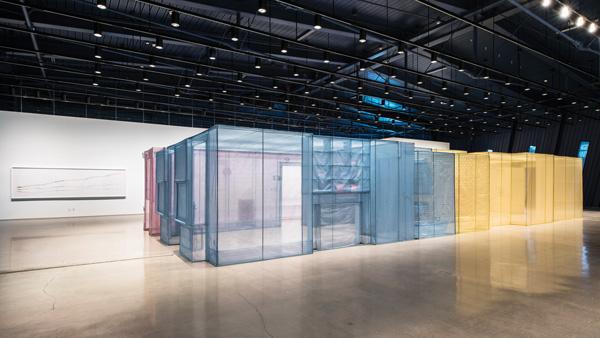The Madison Museum of Contemporary Art’s latest exhibit offers viewers an interactive experience where they are immediately immersed into the personal life and home of Do Ho Suh. The exhibit perfectly captures the surreal feeling that comes with remembering old places of residence.
According to information provided by MMoCA, Suh is a sculptor and artist who was born in Seoul, South Korea in 1962. He came to the U.S. after studying oriental painting at Seoul National University to further his artistic education at the Rhode Island School of Design and Yale University.
His work has been displayed in galleries across the world, including New York City, Los Angeles, London, Seoul and Tokyo, among many others. Suh now lives in and works out of London, New York City and Seoul.
A large portion of the exhibition at the Madison Museum of Contemporary Art is Suh’s recreation of his New York City apartment space. It is exquisitely modeled in transparent, brightly colored polyester fabric, and stainless steel rods give it its more sturdy framework. The sheer amount of detail in the structure is mind-blowing to say the least.
The exhibit consists of several rooms and passageways the visitor can walk through and explore. The first few steps inside transform the surroundings from those of an art gallery to those of an empty apartment in New York. The details connect Suh’s personal memories to the piece while the emptiness leaves space for the visitor’s own imagination.

The juxtaposition of simplicity and extraordinary intricacy is what makes the experience of viewing this work so impactful. The walls are bare, as the structure was designed when Suh was vacating his physical belongings from the space. When looking around inside, however, the viewer can mentally hang or paint anything on those walls.
Suh did not explicitly show viewers what had once been on these walls, he showed them as exposed — open, welcoming and yet empty. There is an open space for the visitors’ own memories, yet Suh created this space by using an extremely personal memory.
After spending more time inside the structure, ideas begin to emerge of what this home could have been. Maybe paintings or bookshelves had once covered the exposed brick wall. On the opposite end of the room from the doorway, maybe there had been a sofa with decorative pillows and a coffee table in front of it. Pictures with family or friends could have lined the hallways between the rooms. In the refrigerator there must have been food, and in the cupboards a variety of dishes, pans and cooking utensils.
Erika Monroe-Kane, MMoCA spokesperson, sees Suh’s work as an accurate visual representation of the feeling of longing for home.
“The transparent quality of it really gives it that ephemeral feeling. It’s concrete, yet completely not,” Monroe-Kane said. “I think that quality of it is really beautiful when you think about the whole topic that he’s exploring.”
In another room, a few individual appliances and parts of the apartment are illuminated the inside and the detailed stitching can easily be viewed. Suh elevates these everyday objects to an entirely different level in this work of art.
Few realize the significance of their relationships with each and every item inside of their home on a daily basis. The space in which someone lives and builds a home subconsciously becomes so central to their existence. It is easy for people to forget how much they depend on the consistency of these objects’ existence until they leave the home they’ve grown to know so well. That’s when they become noteworthy.
Alongside his large structural work, there are several pieces Suh created on paper. His work titled “Staircase,” also created from thread embedded in paper, is a significant symbolic representation of his close friendship with his landlord who lived in the apartment directly above his.
Some of them, including “My Homes” and “Myselves,” are done using thread as his primary medium, often on handmade paper. The images seem to revolve around a similar theme — the sense of home as a part of the person and as a mobile concept that travels along everywhere the physical body goes.
The exhibition will be on display from Feb. 11 until May 14.


